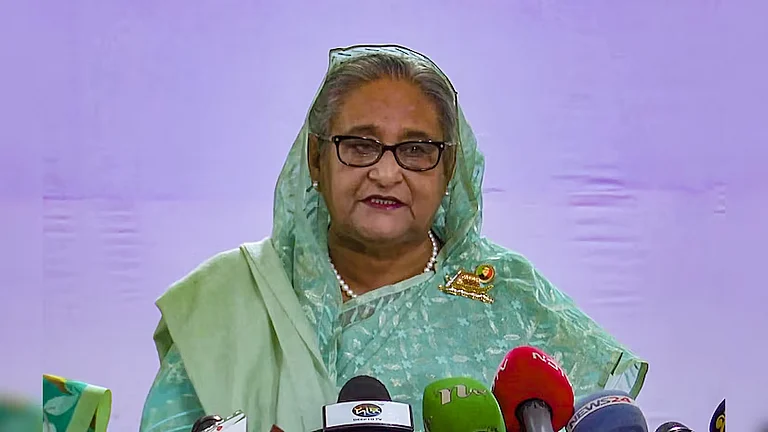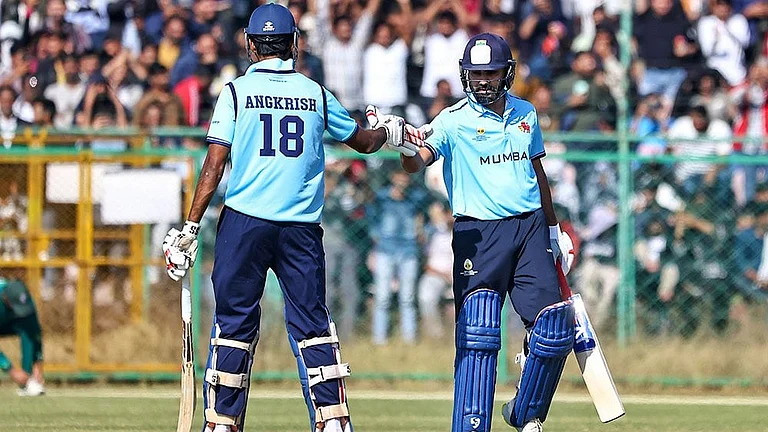CORPORATE performance is down. The country is politically as shaky as it was a week, a month, a year ago. An industrial slowdown looms large over the economy. No new large projects are coming up. And yet, the Sensex soared as if there was no tomorrow. Between June 20 and July 2, the Bombay Stock Exchange Sensitive Index (Sensex) rose 6.1 per cent, breaching the 4300-mark. That's a 15 per cent rise over the last 12 months, and 40 per cent over the last five years. On July 1, the Sensex hit a 52-week high, and the next day, went even further to close at 4334.
The rise of the Sensex has been mainly powered by millions of dollars pouring in from foreign institutional investors (FIIs). And just six months ago, it was these FIIs who seemed to have lost faith in Indian stocks—some were even reportedly considering closing down their India operations. Surely things haven't changed that much since then to so dramatically change the direction of the flow of "hot money"—investor funds moving round the planet looking for good money-making opportunities?
The answer lies in the way FIIs look at stocks, and it's quite different from the Indian investor, be it the omnipotent Unit Trust of India or the neighbourhood punter. While an Indian investor looking at Indian stocks seeks value from a cluster of 5,000-odd companies and chooses from within this group, the FIIs, with offices across the globe, investors around the world, and fund managers on five continents, look at a group of countries as their starting point.
Thus, it is not merely a Hindustan Lever that they buy; the first purchase is India itself. They have to factor in local currency fluctuations into their investment portfolios, and risk is not merely in terms of a profit-earning ratio, management quality or marketshares, but also in terms of exchange rates.
There lies the difference. So, a 40 per cent jump in the Sensex over the last five years translates into a more modest rise of 29 per cent. On hindsight, therefore, investing in South Korea might have been a better idea: on local currency gains of 37 per cent—pretty close to India's Sensex—the total return FIIs got was more than 40 per cent—1.4 times that of India.
To get a clearer picture of the causes of the current FII-led bull run, Outlook has looked at what FIIs see: country performance. We pulled out information about the major indices of 96 countries spread across the globe and analysed them, with respect to India's position. We looked at the index performance of each country or a group of countries on a monthly, yearly, three-yearly and five-yearly basis in both local currency and international gains. Finally, we shortlisted 32 indices, and examined them.
At first glance, the two blue BSE pyramids appear puny next to the Kremlin spire of the Russian index. The Russian index has, after all, very nearly doubled over the last 12 months (data as on July 2), while the BSE National Index has actually fallen, and the Sensex has risen by a mere 4.8 per cent (note that these are sterling-denominated performances that iron out foreign exchange rate fluctuations and give growth rates that are comparable across all stock exchanges of the world). Bete noire China saw its index rise by nearly 58 per cent. Taiwan rose by 27.8 per cent, even Colombo by 18.1 per cent.
But when you consider performance over the last one month, a totally new scenario emerges. Russia continues its headlong journey north, but the BSE Sensex comes in a fairly close second, with the BSE National Index at 1770 following at fifth place with a 6.7 per cent increase. The worst performers were China, Thailand, Bangladesh, the commodities and Pakistan. This is the period when the hot money shifted direction.
It shifted because if one looks underneath the numbers, the ground situation could be surprisingly different. The outstanding performance of the Russian stockmarket, for instance, is nothing out of the ordinary—almost every emerging economy has seen this boom. With the country's economic fundamentals feeble, its legal and enforcement framework dubious, and Yeltsin's health extremely suspect, a lot of FII managers could be beginning to get the heebie-jee-bies. Whenever any country has opened its markets, the first couple of years have seen never-heard-of increases in the indices. It is only once the honeymoon gets over that reality begins to bite. India saw this FII-led, hot-money boom in 1994. And the slump that came later virtually destroyed all confidence in the country.
In Southeast Asia, countries like Thailand, Philippines and Malaysia are finding the downside of hot money. And the funds are baling out. In Thailand, speculators made a run on the baht, the country's currency; the baht was saved only when several Asian central banks ganged up and fought off the attack. The baht didn't drop, but a panicking Thai central jacked up interest rates and FII money rapidly flowed out. In Philippines, a foreign-investor-led speculative frenzy in real estate has turned sour, and the money's exiting. In Malaysia, the stock boom is over, and dollars are on the prowl looking for better pastures.
So in a sense, FII money moving into the Indian bourses is hardly a vote of confidence in the country or its economic policies—the dollars are coming in by a simple process of elimination. Russia's scary, Tokyo, Kuala Lumpur and Manila have been sinking, and China's topped out and has begun falling. And there's that other thing that's forever acting in favour of India: its democratic system. Which, of course, demands a word of caution. Hot money is a nomad, it could roll up its tent and move out at crack of dawn. And leave you cold. For a real boom, real performance is imperative.























